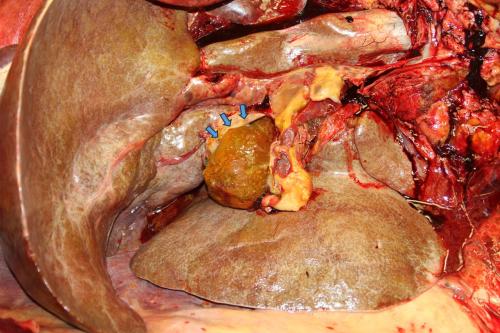CAHFS Connection - November 2024

Managing Editor: Kerry Ballinger
Design Editor: Lucy Gomes
Contributors: Carmen Jerry, Emma Torii, Francisco Uzal, Mark Anderson, Melissa Macias Rioseco, Raul Resendiz-Pozos
Avian
Blackhead disease was diagnosed in eight free-range, White turkeys that showed depression and loss of appetite before dying. On necropsy, all birds had severe liver and cecal necrosis, and abundant Heterakis gallinarum in the cecum. Microscopic examination revealed abundant protozoans compatible with Histomonas meleagridis in the cecum and liver.
Ulcerative enteritis was diagnosed in a flock of six-week-old layer pullets experiencing high mortality for the past four days. Twenty dead birds were submitted for necropsy. Markedly enlarged, mottled and friable spleens, mottled and enlarged livers, cecal cores, and multifocal well circumscribed regions of necrosis with hyperemic margins were noted in the jejunum and ileum of several birds. Clostridium colinum was isolated from the spleens and livers, and Clostridium perfringens was isolated from the intestines. Microscopically, ulcerative enteritis, and hepatic and splenic necrosis with colonies of bacilli were observed. C. colinum is the etiologic agent of ulcerative enteritis, commonly known as quail disease. It can affect quail, chickens, turkeys, pheasants and other gallinaceous birds.
Bovine
Necrotic pharyngitis and laryngitis were associated with bovine herpesvirus type 1 (BHV-1), Fusobacterium necrophorum, and Trueperella pyogenes infections in a three-week-old Holstein calf from a calf-ranch that had respiratory signs before death. About 70% of the lungs had necrosis and hemorrhage with pleuritis. There were multifocal, well-demarcated ulcers in the larynx and soft palate on gross examination. BHV-1 was detected by PCR in the lung and larynx. T. pyogenes and F. necrophorum were isolated from the larynx, and T. pyogenes, Streptococcus suis, and mixed bacteria were isolated from the lungs.
Equine
Cholelithiasis with obstruction of the common bile duct and severe hepatopathy was diagnosed in an 11-year-old bay Warmblood mare with a long-standing history of liver disease and colic. On necropsy, there was a ~ 7cm diameter choledocholith blocking the common bile duct. Grossly, the liver was enlarged and firm, and microscopically it had severe fibrosis, bile duct proliferation, and bile stasis.

Small Ruminant
Mycoplasma mycoides subspecies capri polyarthritis was diagnosed in a one-month-old goat kid submitted after sudden illness and death. At necropsy, the carpi were swollen and contained gray, cloudy fluid. M. mycoides subspecies capri was isolated from multiple joints. The kid was also copper deficient and had moderate coccidiosis.
West Nile virus (WNV) meningoencephalitis was diagnosed in a two-year-old Dorper ewe that had clinical signs for one day. The head was submitted to CAHFS for rabies and polioencephalomalacia evaluation. Histology revealed marked, widespread, lymphohistocytic and neutrophilic meningoencephalitis. Rabies testing was negative and no lesions compatible with polioencephalomalacia were seen. WNV immunohistochemistry was positive. WNV encephalitis is sporadically diagnosed in sheep in California.
Holiday Schedule
- Veterans Day (Monday, November 11): CAHFS will be open, but with limited services available.
- Thanksgiving (Thursday, November 28): CAHFS will be closed.
- Day After Thanksgiving (Friday, November 29): CAHFS will be open, but with limited services. Sample receipt will be available only between 8 AM and 12 PM..
CAHFS is Hiring!
Davis
Histology Technician (SRA2 NEX) - Job# 73869
Process, section and stain animal tissues for microscopic examination. Perform routine H&E, special and immunohistochemical (IHC) stains according to SOPs. Develop and/or evaluate stains with known measures and standards. Prepare histological samples for shipping.
Toxicology Screening Supervisor (LAB RSCH SUPV 2) – Job# 73713
As a group leader, responsible for assignment and coordination of a wide range of test technologies including analysis using GC-MS, LC-MS, and immunoassay analysis. Responsible for the supervision of multiple chemists and staff performing complex analytical testing procedures. Direct research projects for the analysis of small and large molecules in biological matrices. Responsibilities will involve all aspects of research projects including formulating strategies for novel and new extraction and analytical techniques utilizing LC-MS and GC-MS, supervising personnel, researching literature, and summarizing data for publication. Responsible for direct method development work to enhance the drug testing capability of the lab utilizing new technology as available and participating in the update and development of analytical procedures, quality control procedures, and Standard Operating Procedures (SOPs).
Tulare
Biotechnology Technician (SRA 2 NEX) – Job# 73831
Perform the daily functions of a high throughput diagnostic laboratory including performance of nucleic acid-based detection using real time PCR and Standard PCR technology, including processing samples for extraction of DNA and RNA from clinical samples and maintaining documentation records. Assist with evaluation of new equipment, reagents and supplies. Participate in validation studies to ensure system wide performance of assays. Ensure accurate and reproducible assay performance and reporting.
